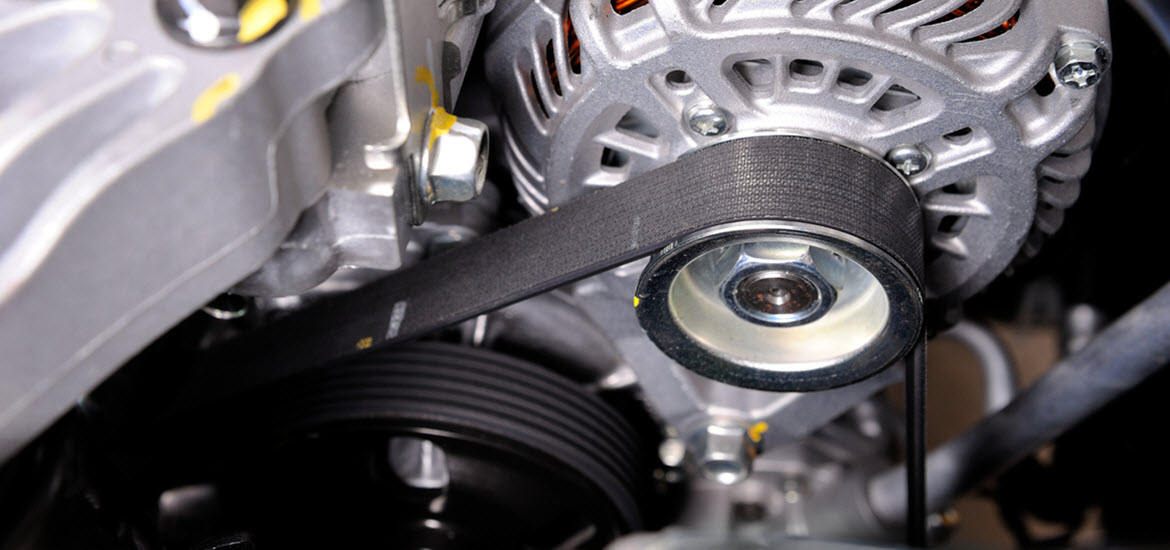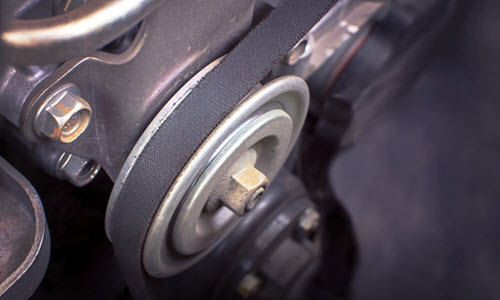Drive Belt Issues in Cars and How to Diagnose Them
- April 4, 2018
- Car Repair
- Posted by Frank Dischinger
- 2 Comments

Auto maintenance is a critical component of car ownership. It requires consistency and dedication to following a routine maintenance plan so that you can avoid the pitfalls of vehicle ownership, which often wind up costing us a ton of money in what otherwise could have been unnecessary repairs. Experiencing issues in your car can be inconvenient and downright scary sometimes; therefore, it’s critical to get your car inspected regularly.
Drive belt issues are common in most vehicles, as the part eventually wears out and needs replacement. It’s essential to follow your recommended maintenance plan for your car so that you can avoid the destructive consequences of a snapped tensioner belt or drive belt. If the belt snaps, it can cause catastrophic engine failure that is often expensive or irreparable. Replacing the belt when early signs of wear are present can spare you great trouble down the line. In this article, we’ll discuss some of the important symptoms to look out for when you suspect your drive belt is failing and what you can do to address the issue.
Symptoms to Look Out For
It’s important to pay close attention to any concerning symptoms that arise in your car so that you can address issues early on before they cause a chain reaction in other parts. If you come across any of the below-mentioned symptoms, it’s best to bring your car into a specialized automotive shop that works with your specific type of car.
Observable Cracks or Fissures in Belt
As time passes and cars incur a sizeable amount of wear, one of the first things to begin deteriorating are the belts and hoses. Belts and hoses are made of materials that don’t wear well in excessively hot conditions—go figure! One way to tell if your belt is beginning to wear out is to occasionally take a peak at the quality of the belt—if it looks like there are cracks or fissures occurring, it’s important to have them inspected and potentially replaced.
Overheating Engine
The drive belt plays a role in helping your engine cool itself by generating enough power to do so. Because of this, when the belt begins to fail or not function properly it can cause your engine to overheat. If your engine overheats it could be due to any number of issues, so it’s important to have your belt checked specifically.
Power Steering Failure
Power steering failure usually occurs when the drive belt has completely failed. As a safeguard, your engine disengages power steering functioning so that you can preserve the engine against the belt potentially snapping if it continues to drive. You’ll need to have your car towed to the nearest vehicle specialist.
Air Conditioner Malfunction
Along with power-steering failure, it is common for the air conditioning to stop functioning as well when the drive belt fails. This is part of what is sometimes called “limp mode” where the powered features, including AC will seize functioning to keep the driver from continuing driving or running the engine.
Concerning Noises Coming From Front End
Sometimes belts aren’t degrading, but are just not properly aligned. This can be just as damaging if the belt is corroding. Usually when the belt becomes misaligned, the driver hears a loud screeching kind of noise coming from where the belt is placed. You should immediately take your car in for an inspection.
The Importance of a Differential Diagnosis
Since many of the above-mentioned symptoms can be due to several different issues  occurring in your car, it’s critical to have a professional perform a differential diagnosis. Differential diagnoses rule out the potential causes of issues by following symptoms to their source and isolating the origin. Here at Glenwood Foreign Car, we serve clients in the areas of Upper Makefield Township, Yardley, Newtown, and Morrisville, PA. Specializing in European imports like BMW, Mercedes, Audi, Porsche, Volvo, Jaguar, Mini Cooper, Land Rover, and Volkswagen, we have a diverse, yet focused area of expertise. If you’re experiencing any of the aforementioned troubling symptoms in your car, or would simply like to get started on a routine maintenance plan, please contact us to schedule an inspection or tune-up.
occurring in your car, it’s critical to have a professional perform a differential diagnosis. Differential diagnoses rule out the potential causes of issues by following symptoms to their source and isolating the origin. Here at Glenwood Foreign Car, we serve clients in the areas of Upper Makefield Township, Yardley, Newtown, and Morrisville, PA. Specializing in European imports like BMW, Mercedes, Audi, Porsche, Volvo, Jaguar, Mini Cooper, Land Rover, and Volkswagen, we have a diverse, yet focused area of expertise. If you’re experiencing any of the aforementioned troubling symptoms in your car, or would simply like to get started on a routine maintenance plan, please contact us to schedule an inspection or tune-up.




2 Comments